Image above: A young Sable Island horse and a young Grey Seal on the north beach. For details, see June 11, 2020 (below).
Series No.1, Zoe’s daily Facebook posts from Sable Island began on June 8, 2020.
Posted on Facebook, July 11, 2020
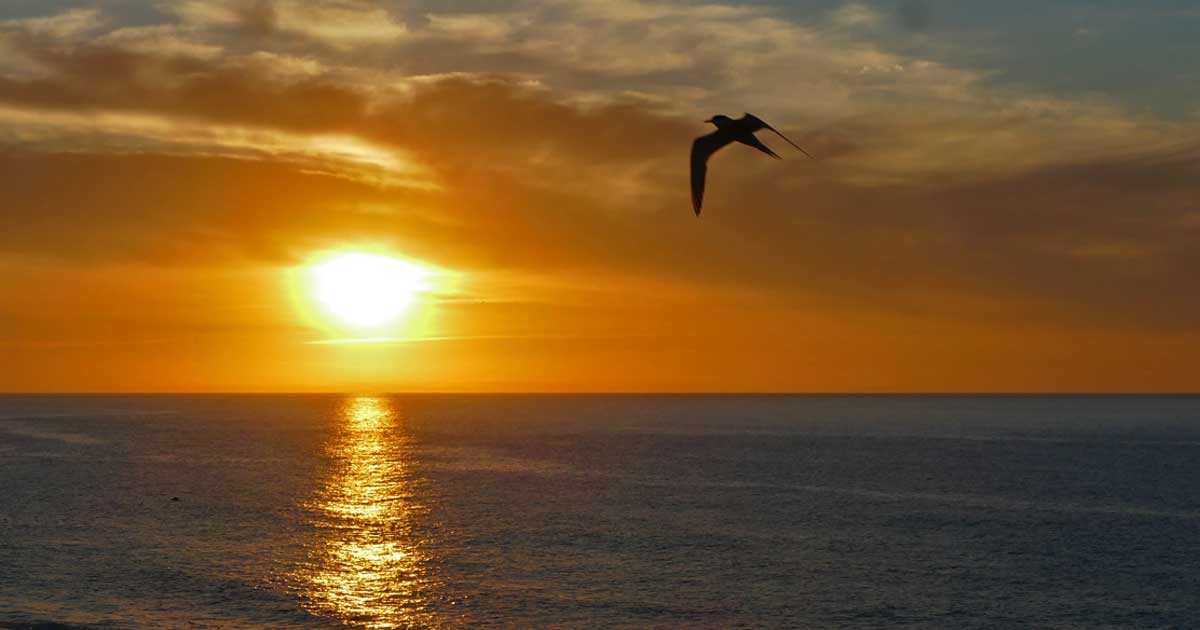
 After almost four months on Sable Island, I returned to Halifax on July 8. This is sunset on July 7 — a view from a high north beach dune, with some terns still flying back and forth between their nesting colony and foraging areas at sea. These are the last images I’ll post from the island for a while. Thanks to all who have liked, shared, commented and otherwise been engaged. I have enjoyed and appreciated being able to share these glimpses of Sable.
After almost four months on Sable Island, I returned to Halifax on July 8. This is sunset on July 7 — a view from a high north beach dune, with some terns still flying back and forth between their nesting colony and foraging areas at sea. These are the last images I’ll post from the island for a while. Thanks to all who have liked, shared, commented and otherwise been engaged. I have enjoyed and appreciated being able to share these glimpses of Sable.
Posted on Facebook, July 7, 2020

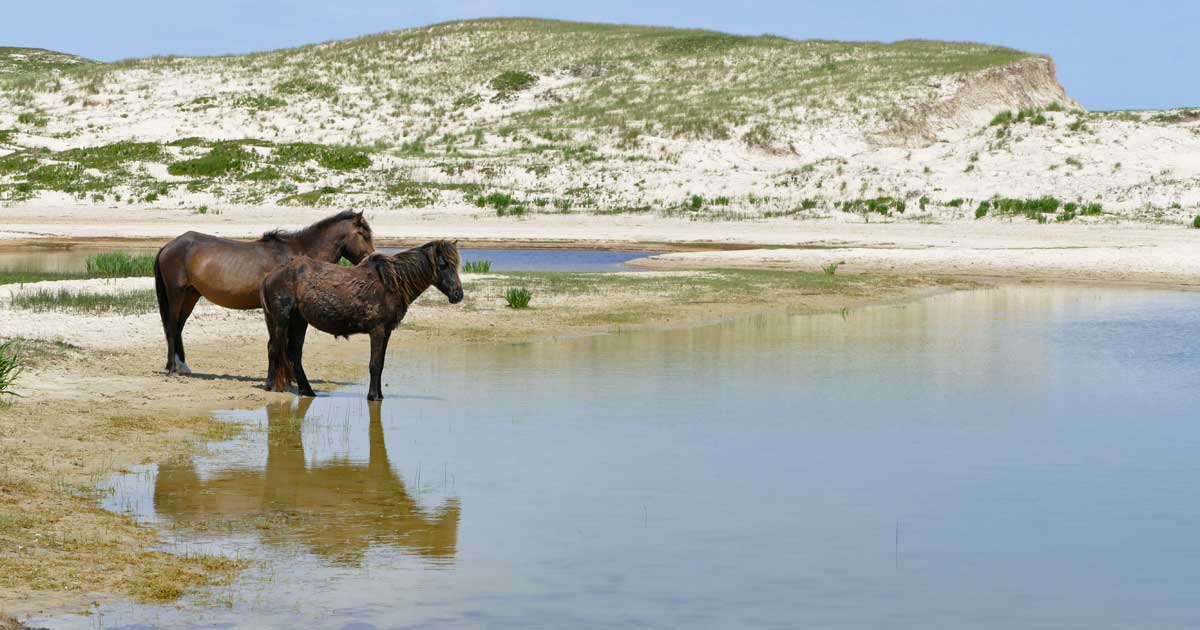 Gallinule Pond, not far from Iris Pond, is the largest freshwater body on the island. It has been called Gallinule since the early 1980s when a film crew spent about three hours trying to get a shot of a Purple Gallinule that was reported to be hiding in the rushes. There was a stand of rushes in those days, but no sign of the bird. There are often horses in the area, drinking, socializing, and resting. Two young males stand at the edge watching other horses in the distance.
Gallinule Pond, not far from Iris Pond, is the largest freshwater body on the island. It has been called Gallinule since the early 1980s when a film crew spent about three hours trying to get a shot of a Purple Gallinule that was reported to be hiding in the rushes. There was a stand of rushes in those days, but no sign of the bird. There are often horses in the area, drinking, socializing, and resting. Two young males stand at the edge watching other horses in the distance.
Posted on Facebook, July 6, 2020

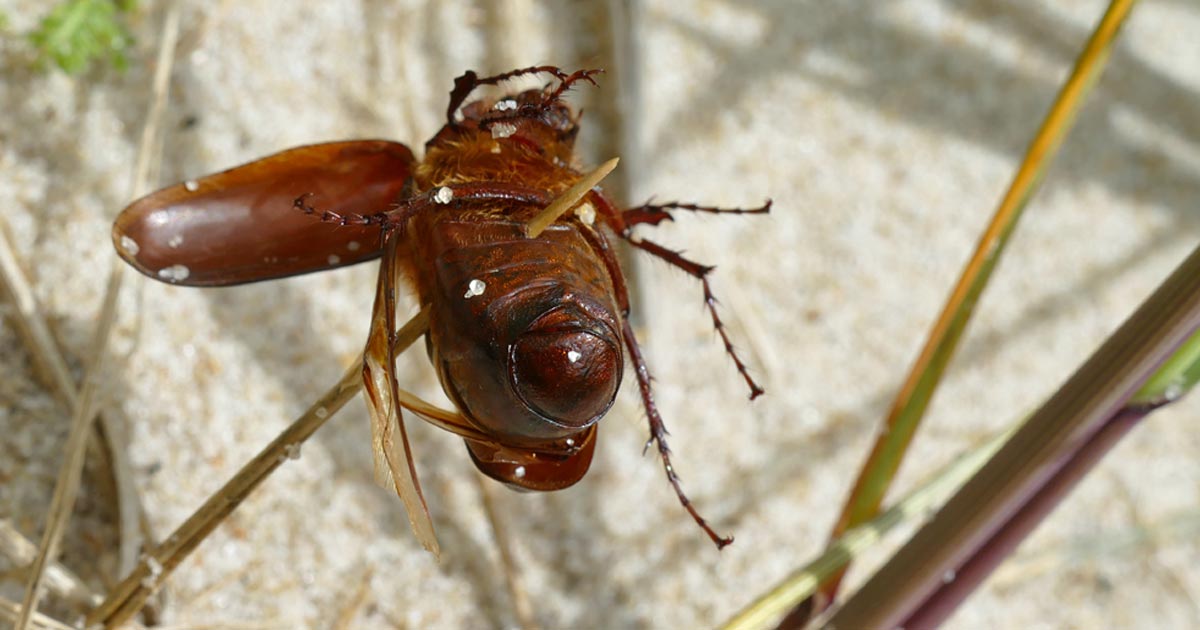 The two largest beetles on the island are the June Beetle (featured earlier) and the Fiery Hunter, both are about 24 mm long. The latter is black with brilliant red, gold or greenish colour in small round depressions (called punctures). This species is known for preying on caterpillars, but it also sometimes feeds on grounded June Beetles. June Beetles not only face being a meal for a Fiery Hunter, but also, apparently, risk impaling themselves on the sharp points of dead marram leaves… backwards…?
The two largest beetles on the island are the June Beetle (featured earlier) and the Fiery Hunter, both are about 24 mm long. The latter is black with brilliant red, gold or greenish colour in small round depressions (called punctures). This species is known for preying on caterpillars, but it also sometimes feeds on grounded June Beetles. June Beetles not only face being a meal for a Fiery Hunter, but also, apparently, risk impaling themselves on the sharp points of dead marram leaves… backwards…?
Posted on Facebook, July 5, 2020

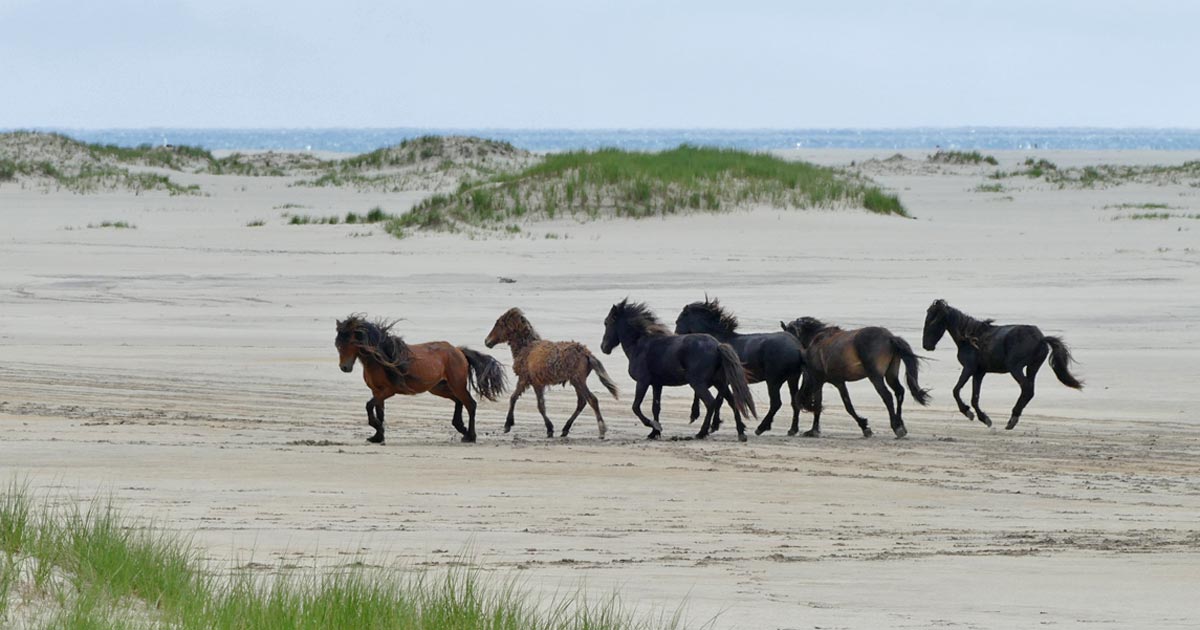 With the Parks Canada vehicle positioned at the start of the runway on south beach, Sable Aviation’s Islander comes in for a landing. The first group of visitors to the Sable Island National Park Reserve for 2020 are about to arrive. However, beforehand, the aircraft had to circle overhead for a few minutes while some frisky Sable horses—a band of buddies, mostly young males—chased each other over the landing strip marked out on the beach.
With the Parks Canada vehicle positioned at the start of the runway on south beach, Sable Aviation’s Islander comes in for a landing. The first group of visitors to the Sable Island National Park Reserve for 2020 are about to arrive. However, beforehand, the aircraft had to circle overhead for a few minutes while some frisky Sable horses—a band of buddies, mostly young males—chased each other over the landing strip marked out on the beach.
Posted on Facebook, July 4, 2020

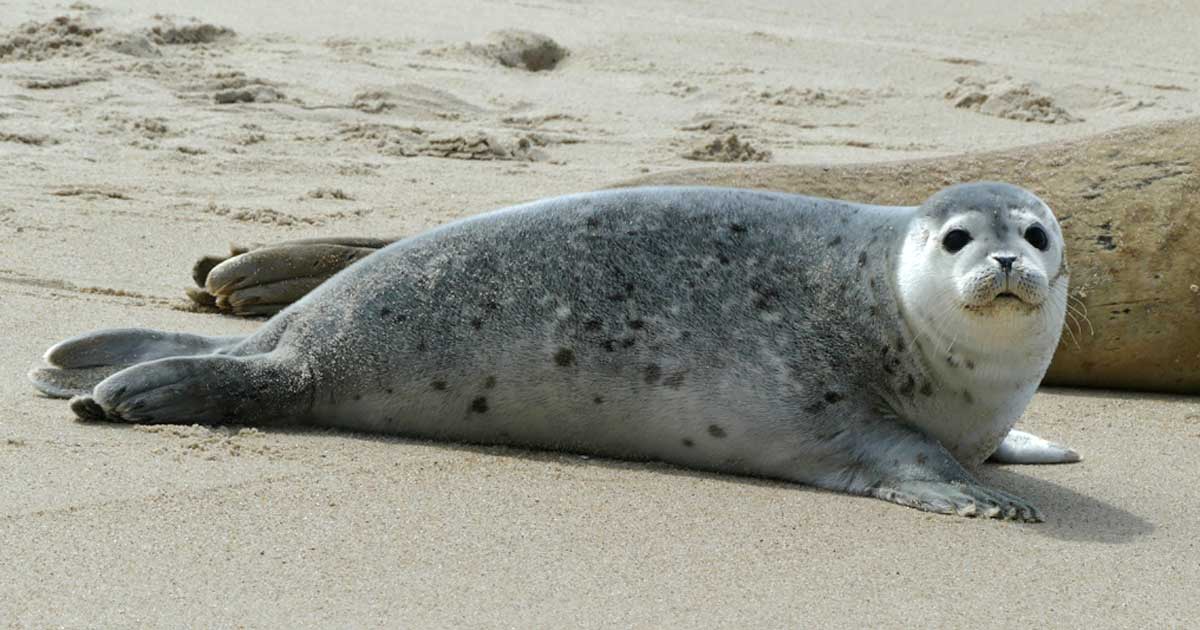 Harbour seal mother and pup, the same pair photo’d on June 9th, 25 days ago. The pup can be identified by a small group of spots on its left side. The mother is thin now, having transferred a lot of her energy to her pup during lactation, and the pup is large, well developed and alert. Its coat is a pattern of light and dark spots on a grey background, and when the mother sheds her worn and grubby coat, she’ll look as speckled and silvery as the pup.
Harbour seal mother and pup, the same pair photo’d on June 9th, 25 days ago. The pup can be identified by a small group of spots on its left side. The mother is thin now, having transferred a lot of her energy to her pup during lactation, and the pup is large, well developed and alert. Its coat is a pattern of light and dark spots on a grey background, and when the mother sheds her worn and grubby coat, she’ll look as speckled and silvery as the pup.
Posted on Facebook, July 3, 2020

 Dune slacks are common on Sable Island. These are low lying depressions between dunes; they are close to the water table and are often flooded during periods of heavy rain and in winter. The permanently moist nature of the slack produces particular plant associations, with cranberry and juncus usually abundant. Juncus is a rush, and its dark green stems contribute to the dune slack’s characteristic darker colour. The tiny juncus flowers, about 3-5 mm, are barely noticeable but worth a close look.
Dune slacks are common on Sable Island. These are low lying depressions between dunes; they are close to the water table and are often flooded during periods of heavy rain and in winter. The permanently moist nature of the slack produces particular plant associations, with cranberry and juncus usually abundant. Juncus is a rush, and its dark green stems contribute to the dune slack’s characteristic darker colour. The tiny juncus flowers, about 3-5 mm, are barely noticeable but worth a close look.
Posted on Facebook, July 2, 2020
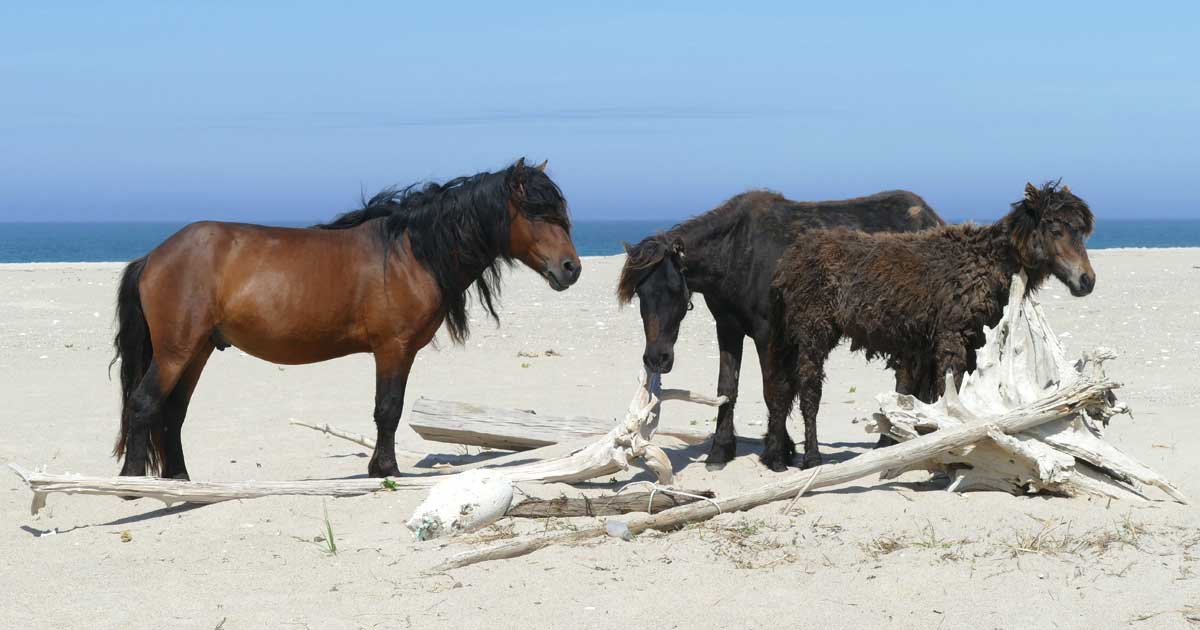
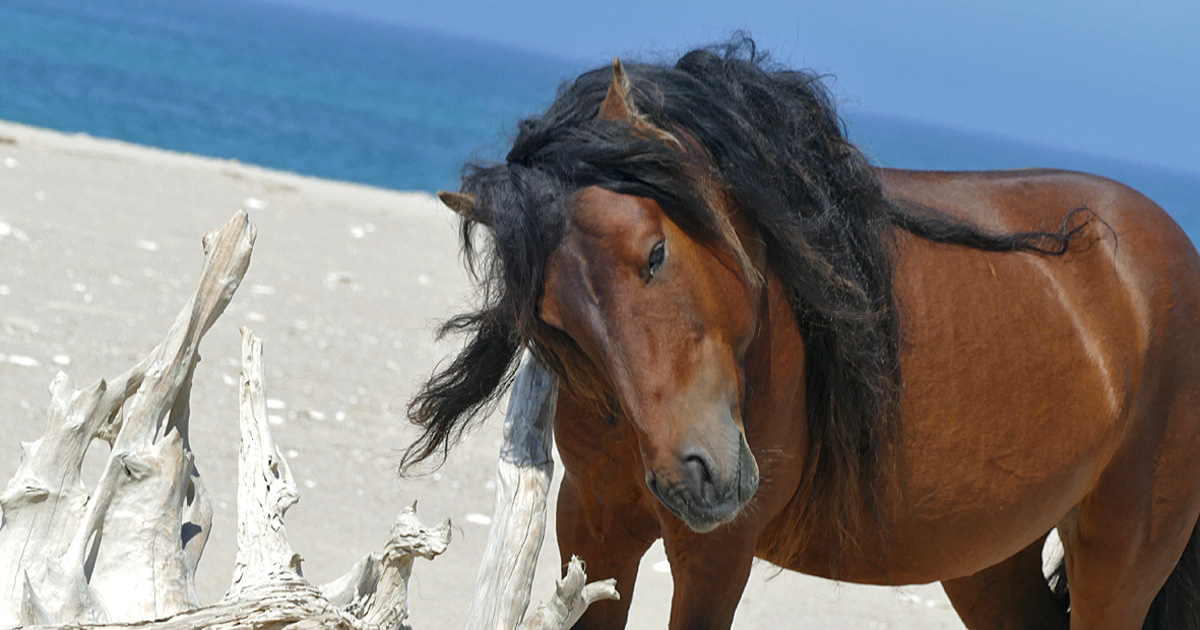 A family band of three on north beach—a stallion fully shed, a mare mostly shed, and a yearling still raggedy. Mutual grooming, rolling, and rubbing helps to relieve the irritation of shedding hair, but even horses with glossy new coats enjoy a rub and a scratch whenever there’s an opportunity. On an island with very few upright surfaces (such as trees), a tangle of driftwood provides for prolonged bouts of blissful scratching, from forehead to tail.
A family band of three on north beach—a stallion fully shed, a mare mostly shed, and a yearling still raggedy. Mutual grooming, rolling, and rubbing helps to relieve the irritation of shedding hair, but even horses with glossy new coats enjoy a rub and a scratch whenever there’s an opportunity. On an island with very few upright surfaces (such as trees), a tangle of driftwood provides for prolonged bouts of blissful scratching, from forehead to tail.
Posted on Facebook, July 1, 2020
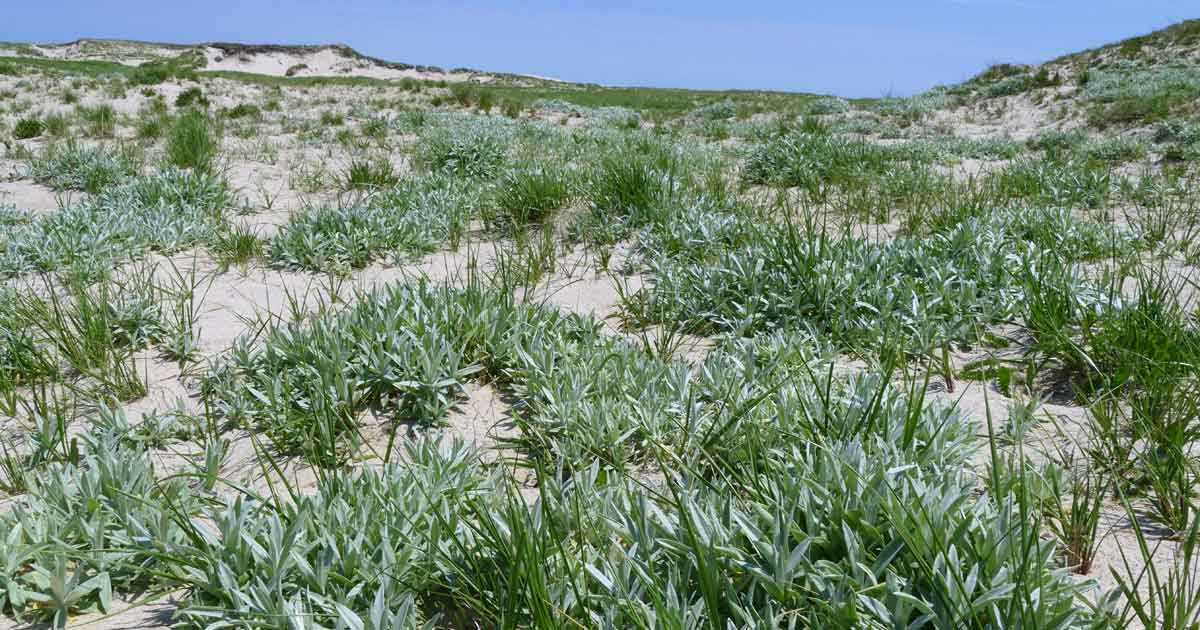
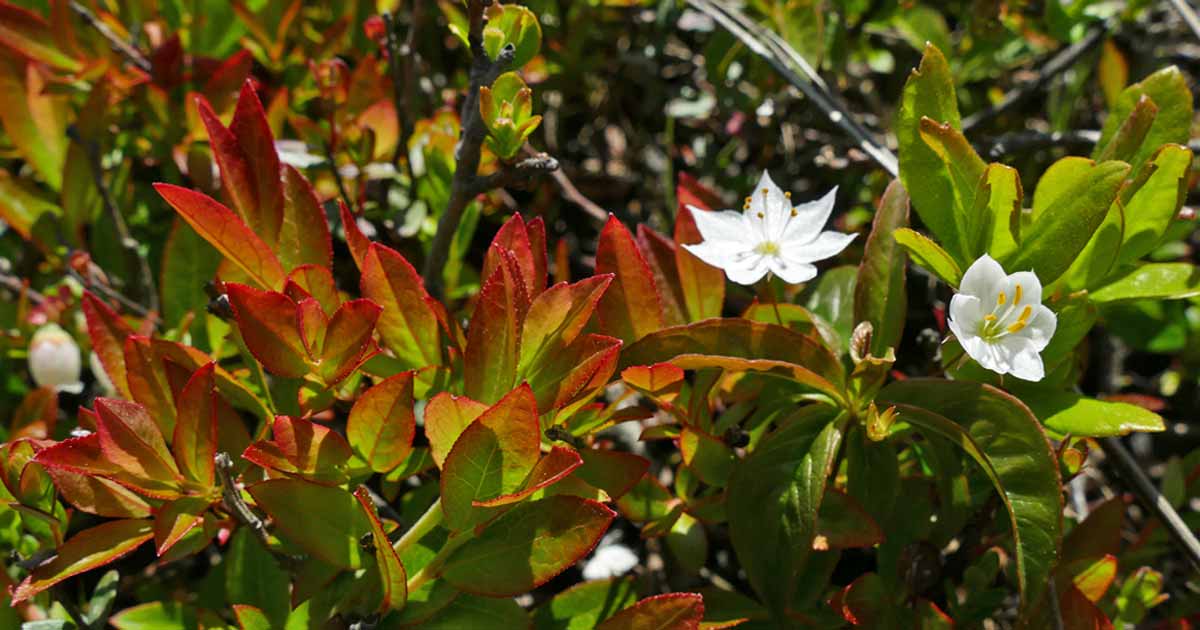 Early summer foliage of Pearly Everlasting and Wild Lowbush Blueberry. These plants are often found growing together with a dozen or more other species, but in some areas one or the other is particularly abundant. Sandy terrain with colonies of pearly and scattered marram grass sometimes resembles a desert sagebrush scene. Blueberry foliage (shown here with two white Starflowers, and some bayberry leaves) looks more like a burst of autumn colours.
Early summer foliage of Pearly Everlasting and Wild Lowbush Blueberry. These plants are often found growing together with a dozen or more other species, but in some areas one or the other is particularly abundant. Sandy terrain with colonies of pearly and scattered marram grass sometimes resembles a desert sagebrush scene. Blueberry foliage (shown here with two white Starflowers, and some bayberry leaves) looks more like a burst of autumn colours.
Posted on Facebook, June 30, 2020
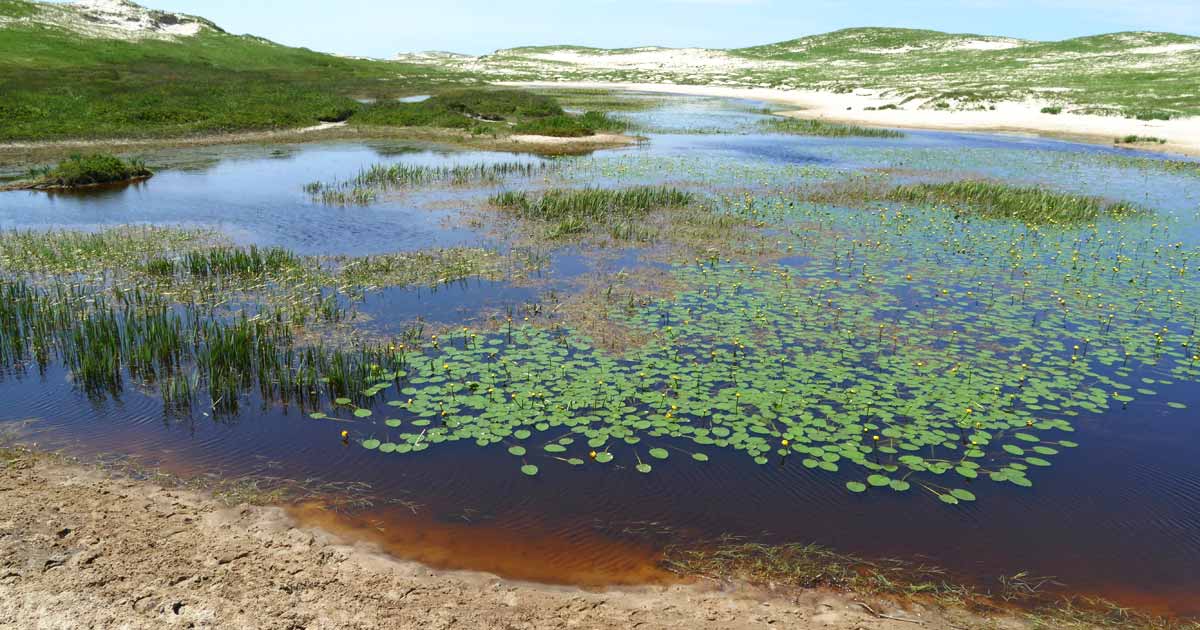
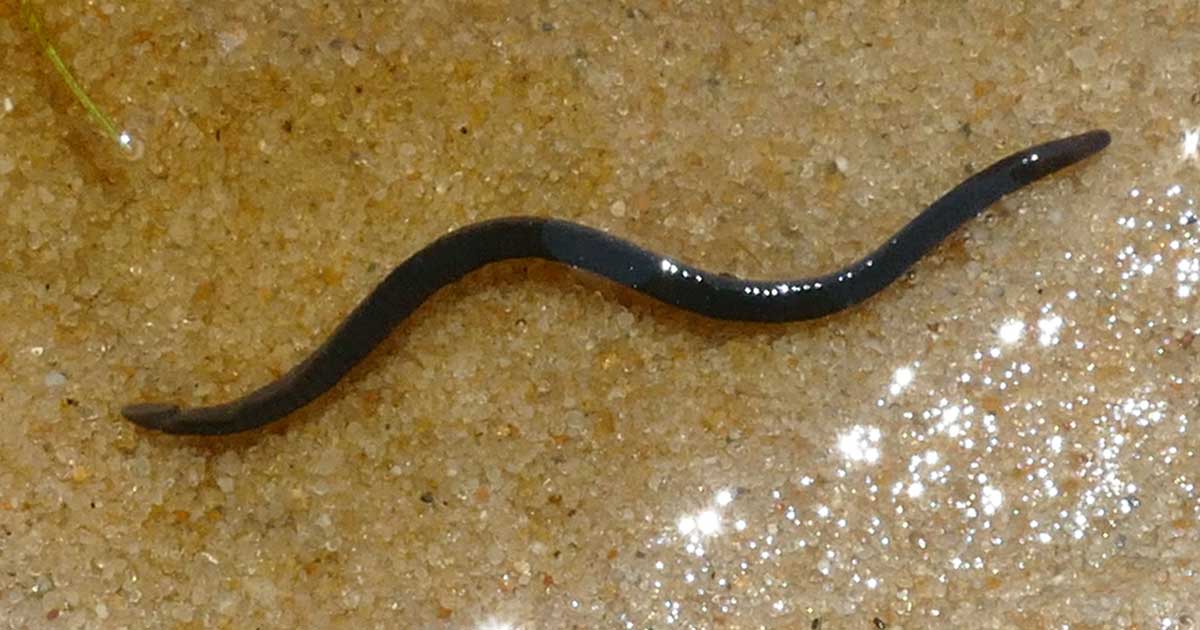 Like many ponds on Sable Island, Iris Pond gets smaller and shallower as wind-blown sand moves over the dunes and into the pond. This affects biodiversity—some pond organisms are not able to survive in the changing conditions (e.g., water chemistry and temperature). There are still leeches in Iris Pond, visible when they emerge to forage in wet sand along the water’s edge. This one is about 5 cm long; endearing creatures when you get to know them.
Like many ponds on Sable Island, Iris Pond gets smaller and shallower as wind-blown sand moves over the dunes and into the pond. This affects biodiversity—some pond organisms are not able to survive in the changing conditions (e.g., water chemistry and temperature). There are still leeches in Iris Pond, visible when they emerge to forage in wet sand along the water’s edge. This one is about 5 cm long; endearing creatures when you get to know them.
Posted on Facebook, June 29, 2020
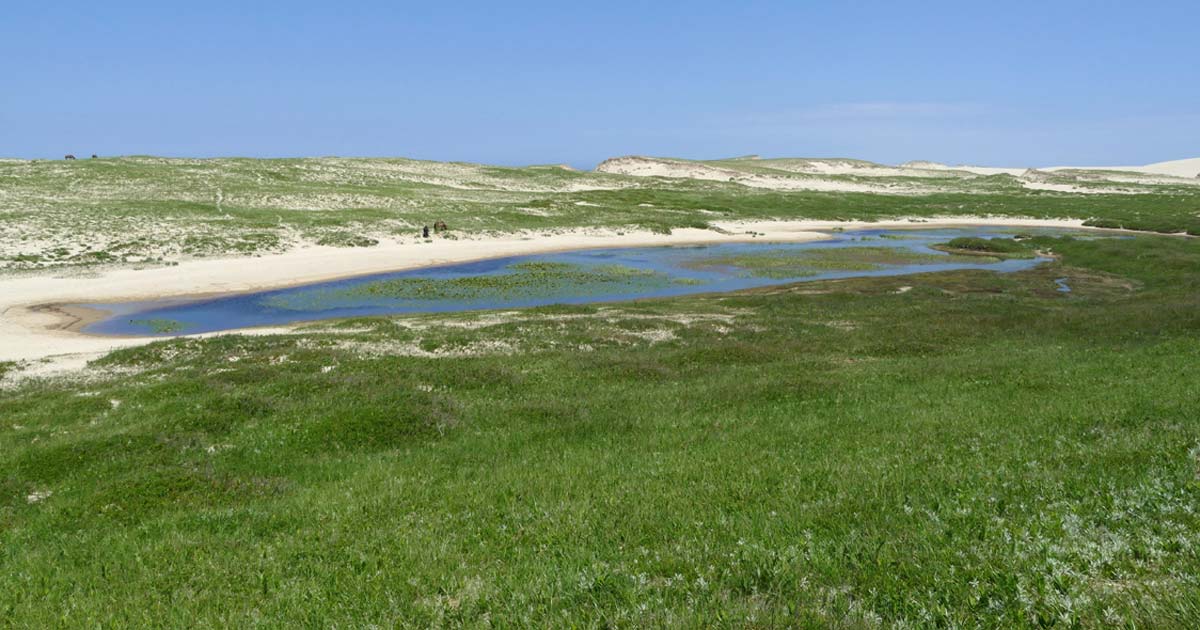
 Iris Pond is in the centre of Sable Island (i.e., located roughly halfway between the east and west ends of the vegetated dune system). There are no freshwater ponds on the eastern half of Sable. The pond was named for its abundant Blue Flag Iris, but the iris stand has diminished, and Yellow Pond-lily (also known as Bullhead Pond-lily) now dominates the pondscape. A young mare and a stallion, grazing marram grass on the slope, come down for a drink.
Iris Pond is in the centre of Sable Island (i.e., located roughly halfway between the east and west ends of the vegetated dune system). There are no freshwater ponds on the eastern half of Sable. The pond was named for its abundant Blue Flag Iris, but the iris stand has diminished, and Yellow Pond-lily (also known as Bullhead Pond-lily) now dominates the pondscape. A young mare and a stallion, grazing marram grass on the slope, come down for a drink.
Posted on Facebook, June 28, 2020
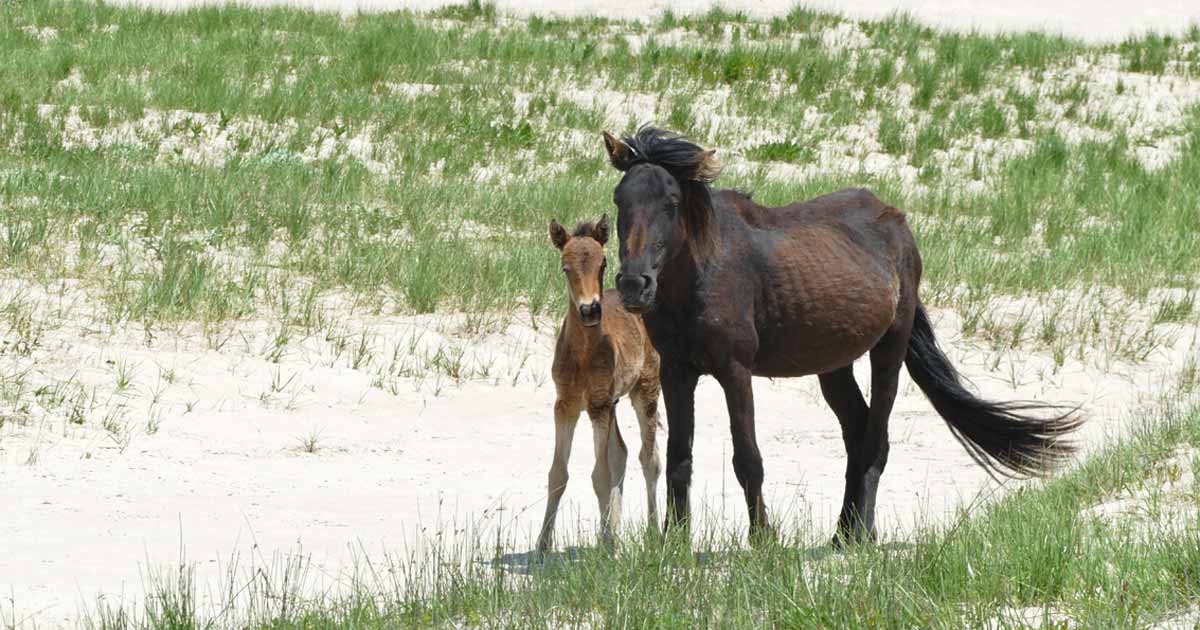
 Enjoying a cool breeze blowing across a sandy meadow, a Sable Island mare rests and occasionally snoozes. Her male foal sets off to explore a patch of Blue Flag Iris growing in a moist hollow nearby. Most Sable foals are born during May and June, with the earliest born in the latter half of March. Some mares give birth in July and later, and a few December foaling dates have been recorded—but these are very unusual.
Enjoying a cool breeze blowing across a sandy meadow, a Sable Island mare rests and occasionally snoozes. Her male foal sets off to explore a patch of Blue Flag Iris growing in a moist hollow nearby. Most Sable foals are born during May and June, with the earliest born in the latter half of March. Some mares give birth in July and later, and a few December foaling dates have been recorded—but these are very unusual.
Posted on Facebook, June 27, 2020
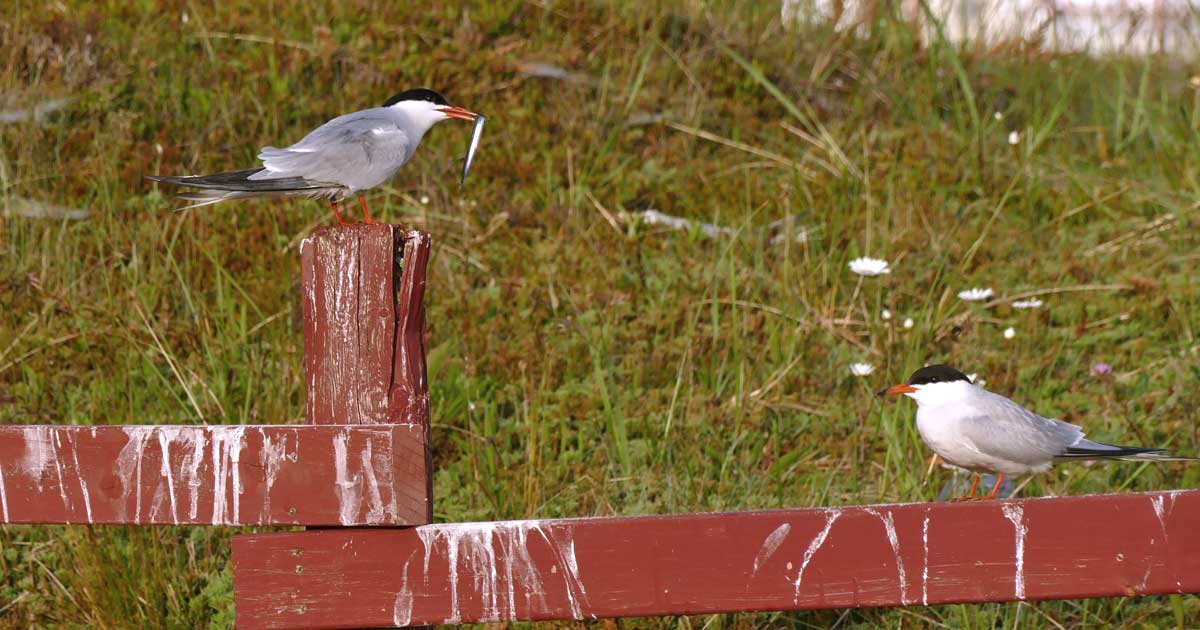
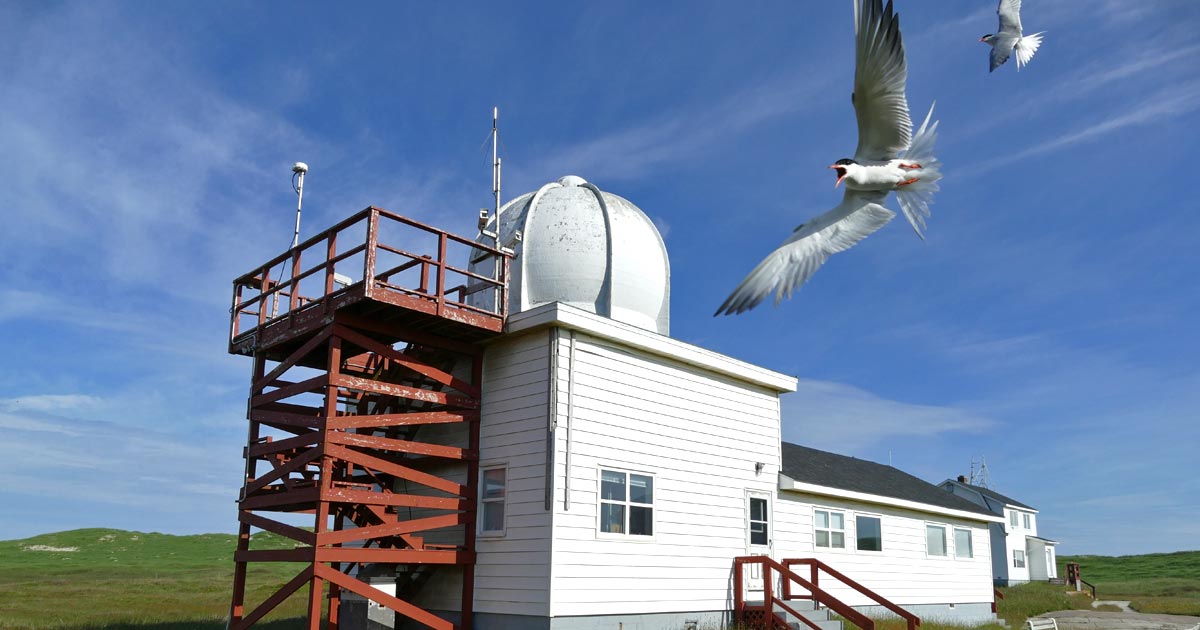 Two Common Terns standing on a wooden fence at the station. Even though there’s a lot of activity here—people and vehicles moving about—terns have built nests along the fence. One of the terns has just returned from foraging at sea and holds a small fish, a sandlance. Many chicks have hatched and the adults are bringing food for them. With chicks to care for, the adult terns seem to have expanded their territorial claim at the station.
Two Common Terns standing on a wooden fence at the station. Even though there’s a lot of activity here—people and vehicles moving about—terns have built nests along the fence. One of the terns has just returned from foraging at sea and holds a small fish, a sandlance. Many chicks have hatched and the adults are bringing food for them. With chicks to care for, the adult terns seem to have expanded their territorial claim at the station.
Posted on Facebook, June 26, 2020
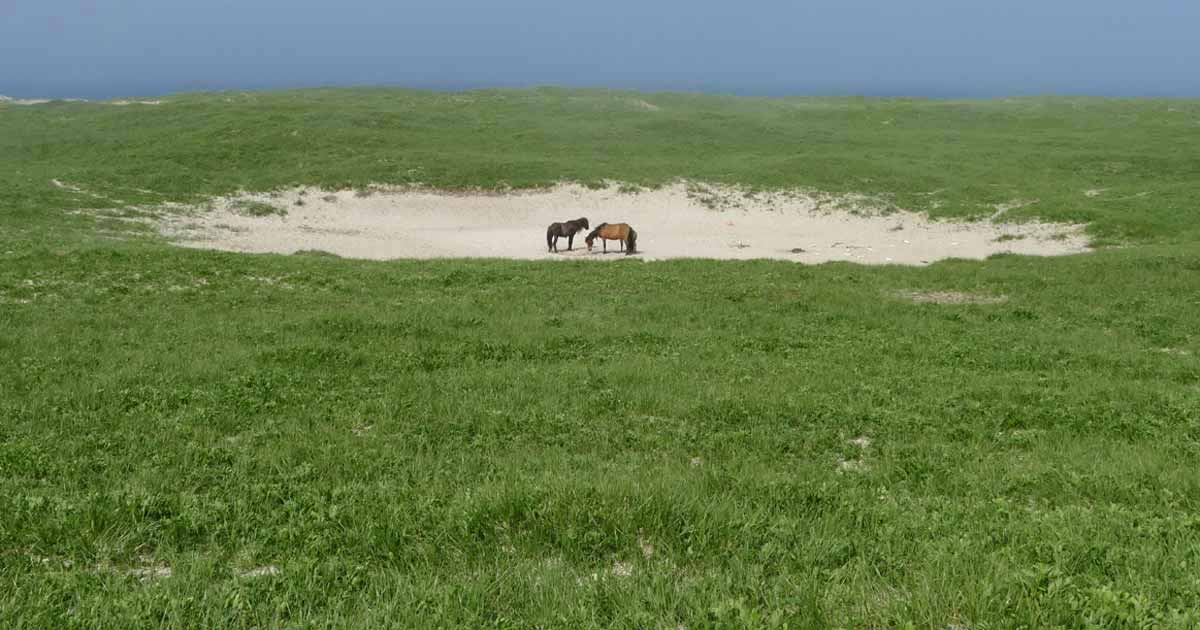
 At times, there can be as many as a hundred horses grazing on West Spit. This area, the western end of Sable Island, is covered with dense stands of marram, pea, and sandwort, and roughly in the middle is a water hole site, an oval of bare sand. Between drinks, a mare uses her front feet to clear sand out of the hole. Depending on the season and weather, horses may dig through a few centimeters to more than 40 cm down to reach water.
At times, there can be as many as a hundred horses grazing on West Spit. This area, the western end of Sable Island, is covered with dense stands of marram, pea, and sandwort, and roughly in the middle is a water hole site, an oval of bare sand. Between drinks, a mare uses her front feet to clear sand out of the hole. Depending on the season and weather, horses may dig through a few centimeters to more than 40 cm down to reach water.
Posted on Facebook, June 25, 2020
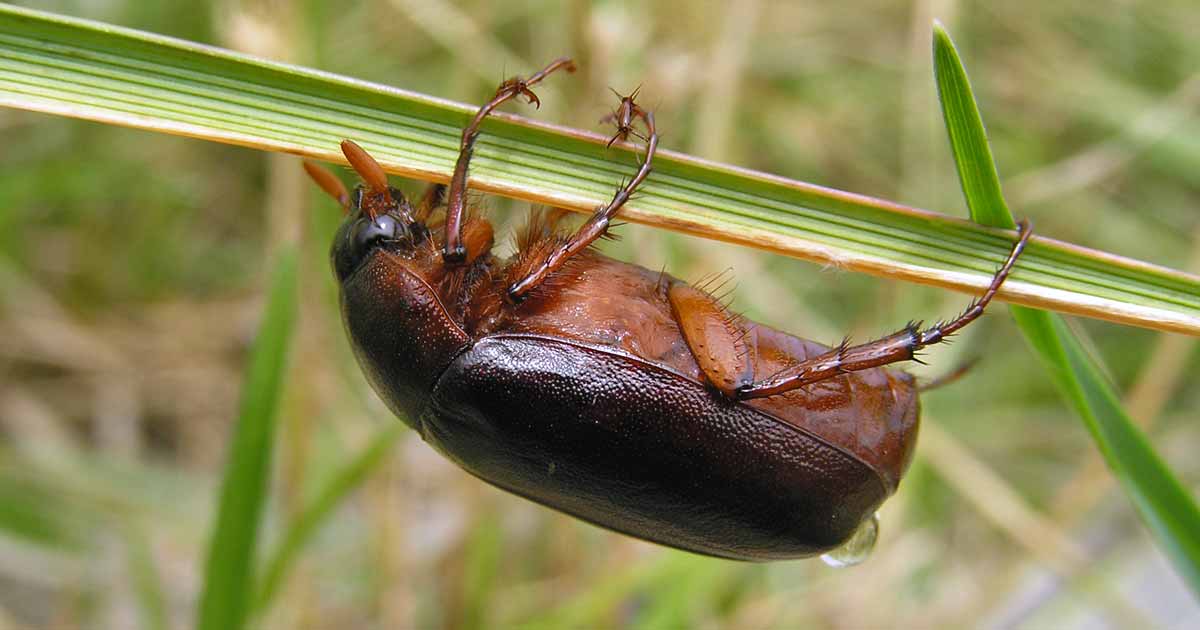
 June beetles are abundant on Sable. At night 100s turn up around lights at the station and pelt themselves against window panes. This species, a member of the scarab family, is one of the largest beetles on the island, about 24 mm long. It eats leaves and flowers, and doesn’t bite or sting. But during its nocturnal flights, it easily gets caught up in clothing and hair when it blunders at high speed into a person walking past an outdoor light.
June beetles are abundant on Sable. At night 100s turn up around lights at the station and pelt themselves against window panes. This species, a member of the scarab family, is one of the largest beetles on the island, about 24 mm long. It eats leaves and flowers, and doesn’t bite or sting. But during its nocturnal flights, it easily gets caught up in clothing and hair when it blunders at high speed into a person walking past an outdoor light.
Posted on Facebook, June 24, 2020

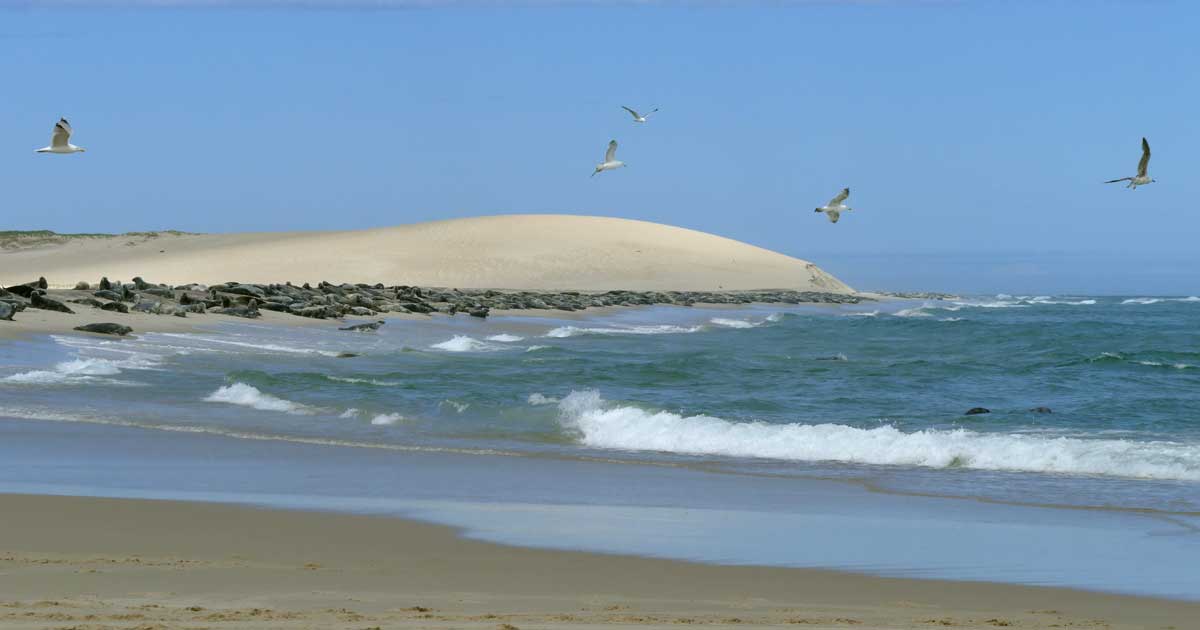 Looking westward along north beach, East Light Tower is in the distance, and a few groups of Grey Seals are resting at the edge of the water. There are two light towers on Sable Island, one east and one west. Both have been decommissioned. On the south side of the island, not far from East Light, there’s a huge bald dune, and more seals. The wind-driven dune has been moving across the island and is now sliding into the waves.
Looking westward along north beach, East Light Tower is in the distance, and a few groups of Grey Seals are resting at the edge of the water. There are two light towers on Sable Island, one east and one west. Both have been decommissioned. On the south side of the island, not far from East Light, there’s a huge bald dune, and more seals. The wind-driven dune has been moving across the island and is now sliding into the waves.
Posted on Facebook, June 23, 2020
 In early summer, the Sable landscape is brightened by wildflowers. Two plants that are just beginning to bloom are the iris called Northern Blue Flag, and Beach Pea. The iris is most common near and in freshwater ponds, and the pea is abundant on the dunes, usually growing with marram grass. The horses occasionally eat the leaves of iris, but beach pea is a very important component of their diet, especially in late summer and fall.
In early summer, the Sable landscape is brightened by wildflowers. Two plants that are just beginning to bloom are the iris called Northern Blue Flag, and Beach Pea. The iris is most common near and in freshwater ponds, and the pea is abundant on the dunes, usually growing with marram grass. The horses occasionally eat the leaves of iris, but beach pea is a very important component of their diet, especially in late summer and fall.
Posted on Facebook, June 22, 2020
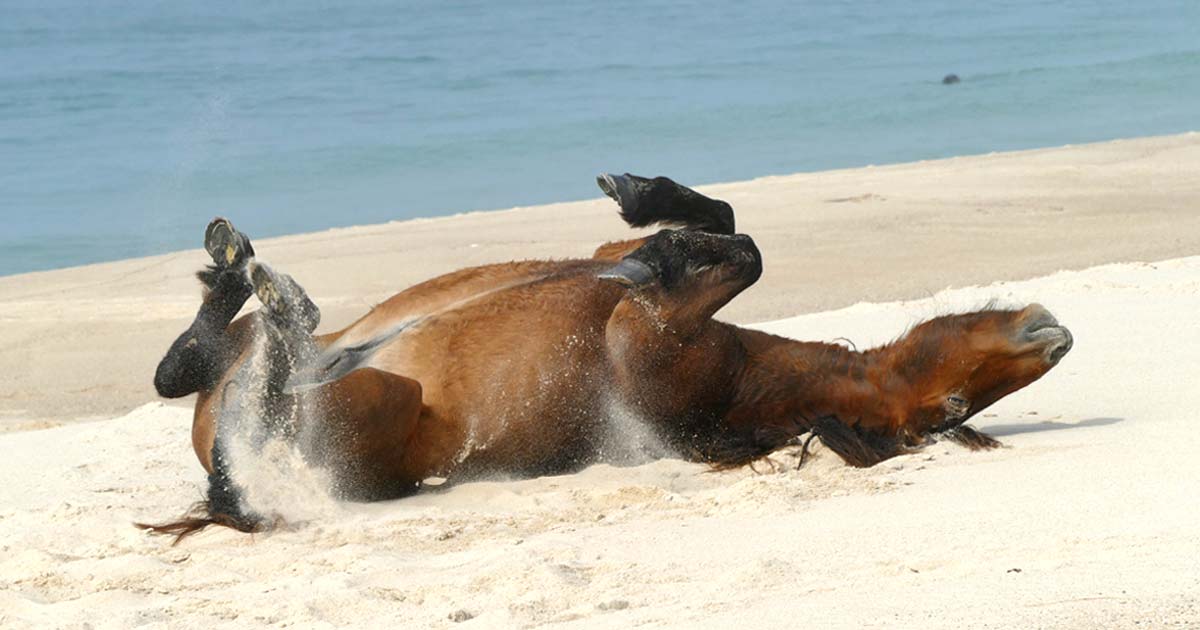 Yesterday afternoon, balmy with a light easterly breeze, and a maximum temperature of 14.7°C. After ambling along north beach, sniffing the ground and bits of twigs and seaweed washed ashore, a solitary stallion comes to a patch of scuffed and churned sand where a horse, or maybe a few horses, had rolled and rubbed, a short while earlier. He drops down, and rolls back and forth and wriggles his back in the cool, damp sand. Aaaaah…
Yesterday afternoon, balmy with a light easterly breeze, and a maximum temperature of 14.7°C. After ambling along north beach, sniffing the ground and bits of twigs and seaweed washed ashore, a solitary stallion comes to a patch of scuffed and churned sand where a horse, or maybe a few horses, had rolled and rubbed, a short while earlier. He drops down, and rolls back and forth and wriggles his back in the cool, damp sand. Aaaaah…
Posted on Facebook, June 21, 2020
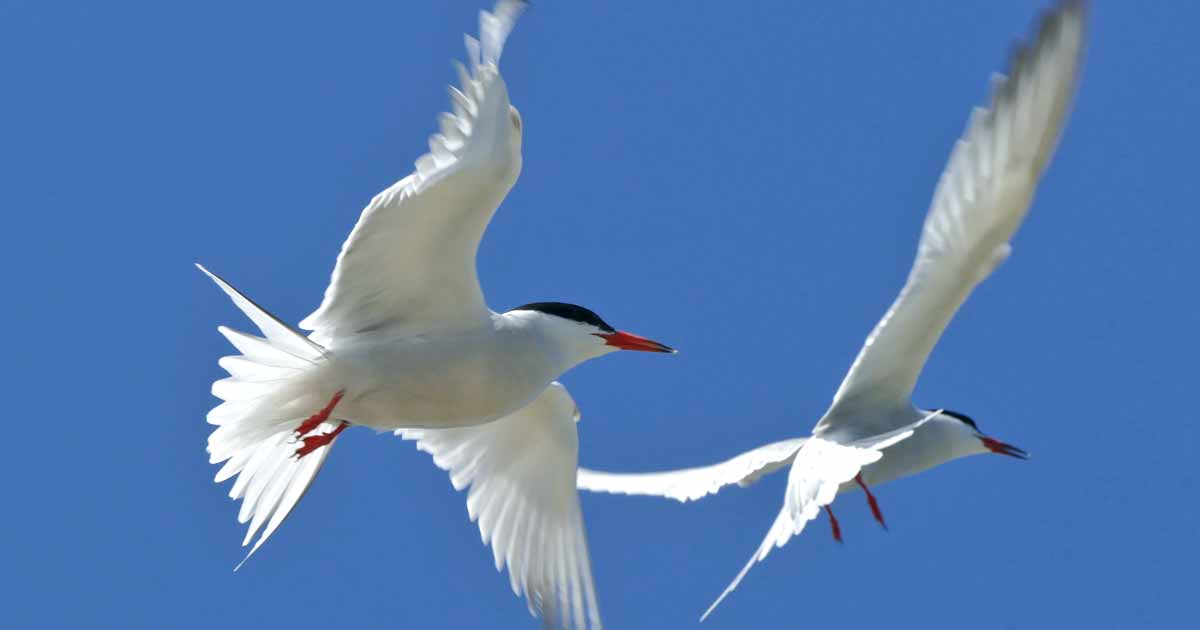
 Three tern species breed on the island: Common, Arctic and Roseate. One of the two largest nesting colonies is near the Sable Island Station. Each year the edge of the colony has crept a little closer as some terns choose to establish their nests near station structures and activities. This spring a few of the most neighbourly of the terns laid claim to the instrumentation field and settled amongst the weather sensors and gauges.
Three tern species breed on the island: Common, Arctic and Roseate. One of the two largest nesting colonies is near the Sable Island Station. Each year the edge of the colony has crept a little closer as some terns choose to establish their nests near station structures and activities. This spring a few of the most neighbourly of the terns laid claim to the instrumentation field and settled amongst the weather sensors and gauges.
Posted on Facebook, June 20, 2020

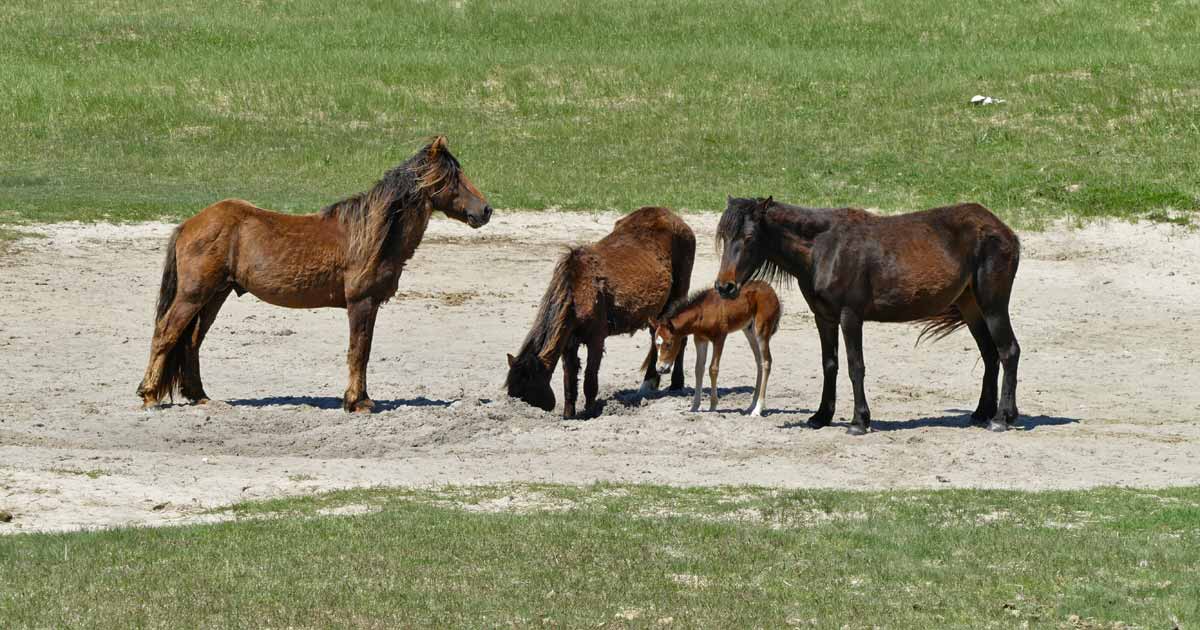 In the Steeple Dune area (named decades ago for a steeple-shaped dune that has long since disappeared) there is a low, sandy flat where horses dig for water. This water hole site, surrounded by a rich field of grass and pea, is used by many different bands throughout the day. While a mare drinks (her foal by her side), the stallion is intently watching another band in the distance, walking towards the water hole.
In the Steeple Dune area (named decades ago for a steeple-shaped dune that has long since disappeared) there is a low, sandy flat where horses dig for water. This water hole site, surrounded by a rich field of grass and pea, is used by many different bands throughout the day. While a mare drinks (her foal by her side), the stallion is intently watching another band in the distance, walking towards the water hole.
Posted on Facebook, June 19, 2020

 As part of the beached plastics study, the Sable Island Institute conducts “brand audits” which provide information about containers and packaging, used for industrial and consumer products, that end up adrift in the ocean and washed ashore on Sable. The study is based on beach surveys for items that have all or most labeling intact—bags and snack wrappers, as well as the more obvious buckets, bottles, jugs, and tubs.
As part of the beached plastics study, the Sable Island Institute conducts “brand audits” which provide information about containers and packaging, used for industrial and consumer products, that end up adrift in the ocean and washed ashore on Sable. The study is based on beach surveys for items that have all or most labeling intact—bags and snack wrappers, as well as the more obvious buckets, bottles, jugs, and tubs.
Posted on Facebook, June 18, 2020

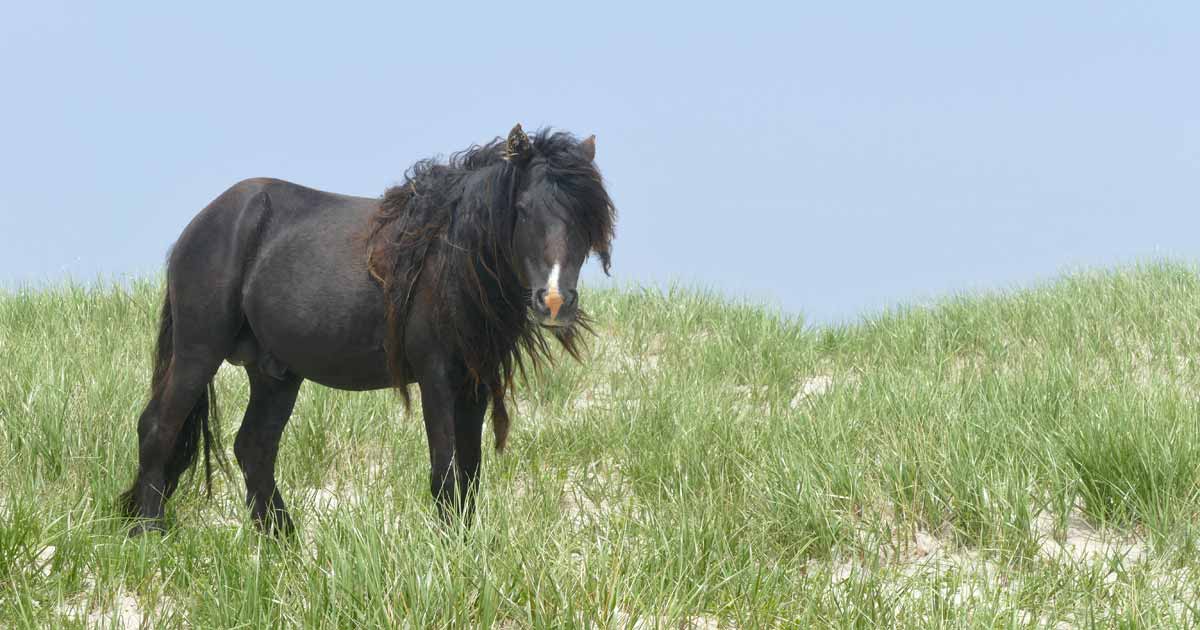 A breezy afternoon on Sable Island, with the temperature peaking at 16.7°C. A family band is resting on a beach slope along the south side of West Spit. The horses are in various stages of shedding their winter coats—the mares and younger horses still look raggedy with hanging clumps of matted hair. However, the band stallion has almost completed the transition and his coat is beginning to look glossy.
A breezy afternoon on Sable Island, with the temperature peaking at 16.7°C. A family band is resting on a beach slope along the south side of West Spit. The horses are in various stages of shedding their winter coats—the mares and younger horses still look raggedy with hanging clumps of matted hair. However, the band stallion has almost completed the transition and his coat is beginning to look glossy.
Posted on Facebook, June 17, 2020
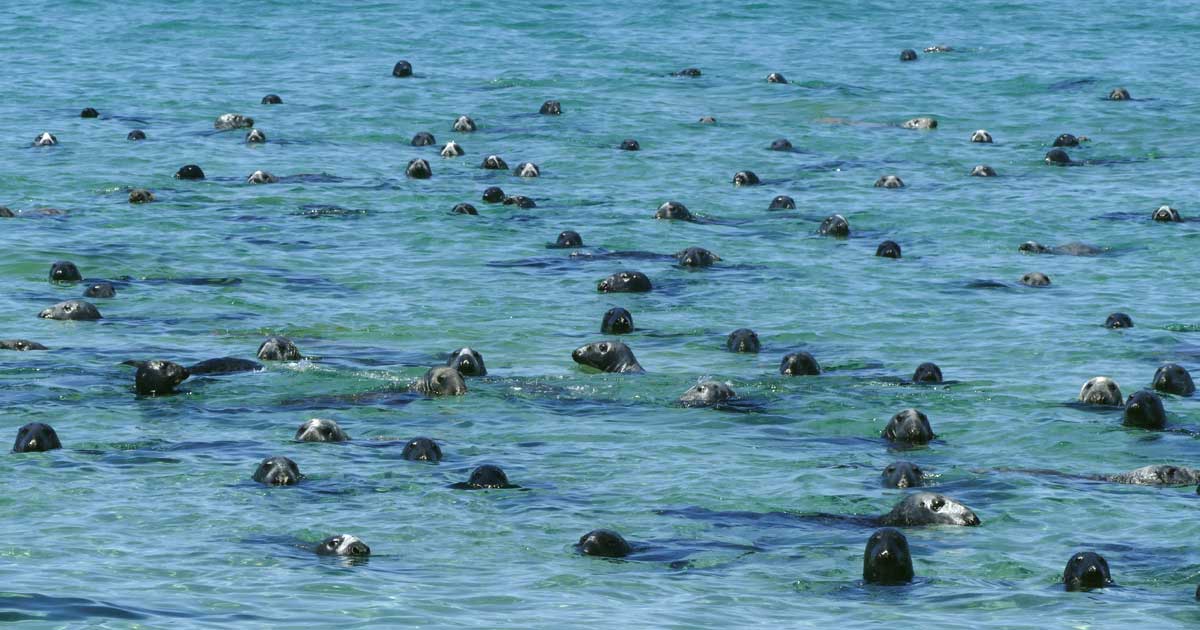
 A day of light wind and calm sea conditions along the north beach. Sable Island Grey Seals hang in the water, curious, watching a person with a camera watching them. Aside from a few snorts and huffs, the seals are quiet. Suddenly, they dive, and within seconds all of them are gone under sprays, splashes and slapping water. It makes a person look around to see what startled the seals, but there’s nothing… obvious.
A day of light wind and calm sea conditions along the north beach. Sable Island Grey Seals hang in the water, curious, watching a person with a camera watching them. Aside from a few snorts and huffs, the seals are quiet. Suddenly, they dive, and within seconds all of them are gone under sprays, splashes and slapping water. It makes a person look around to see what startled the seals, but there’s nothing… obvious.
Posted on Facebook, June 16, 2020
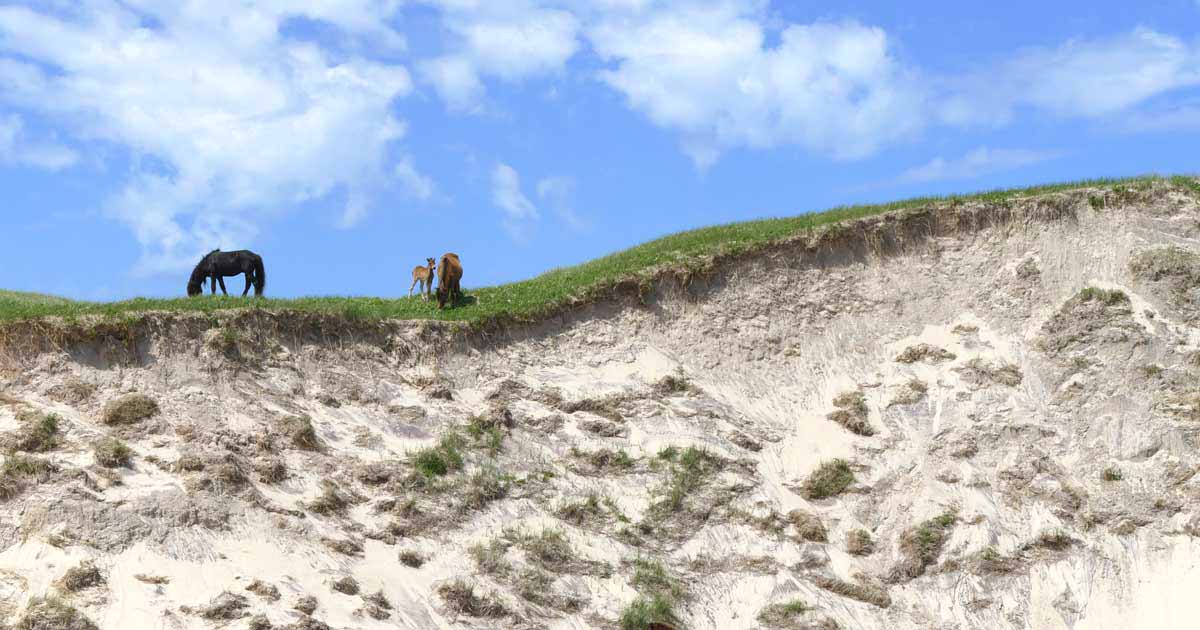
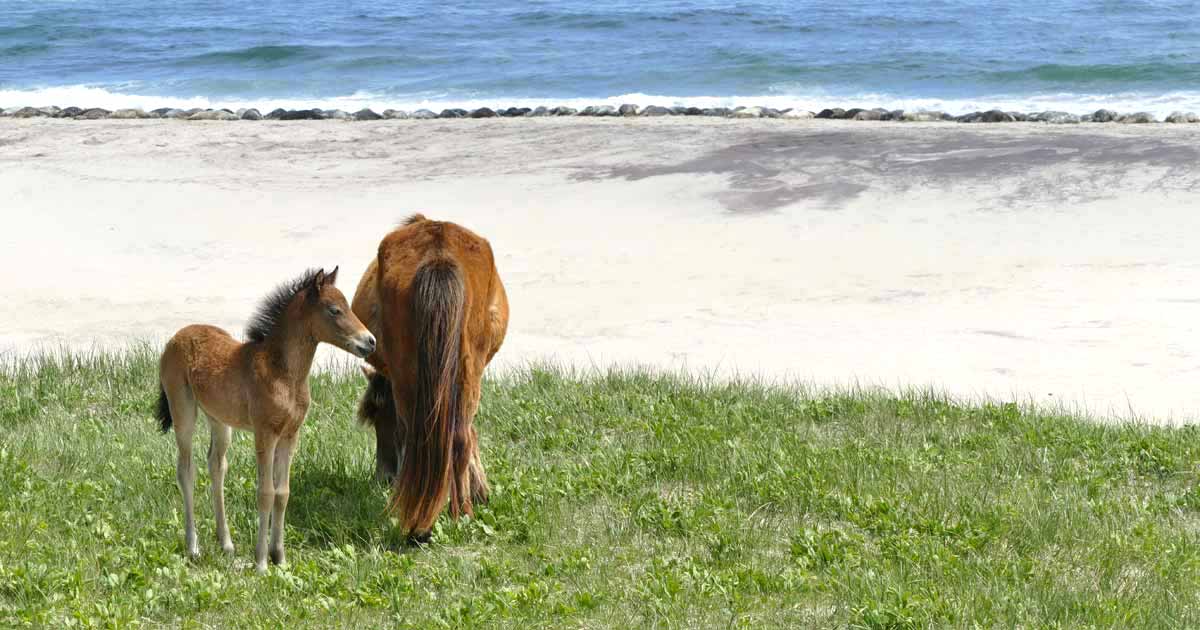 A family band of Sable Island horses—a black stallion, a bay mare and her female foal—on the top of a high dune overlooking the south beach. While the adults are focussed on grazing, the foal nibbles leaves of marram grass and wild pea, takes naps, and explores, never moving too far from her mother. In the distance, near the water, what looks like a line of boulders is actually 100s of grey seals resting on the beach.
A family band of Sable Island horses—a black stallion, a bay mare and her female foal—on the top of a high dune overlooking the south beach. While the adults are focussed on grazing, the foal nibbles leaves of marram grass and wild pea, takes naps, and explores, never moving too far from her mother. In the distance, near the water, what looks like a line of boulders is actually 100s of grey seals resting on the beach.
Posted on Facebook, June 15, 2020

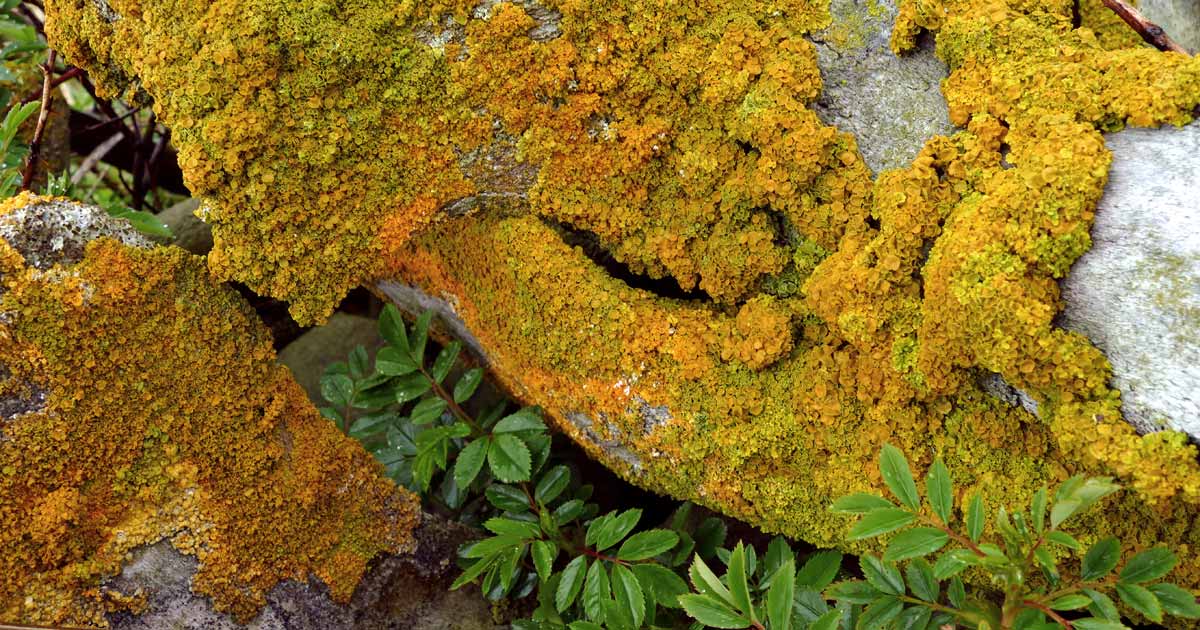 After a day of fog and rain (about 20 mm), the landscape is soggy and dripping, and in the distance the pale dunes seem to dissolve into the grey sky like a watercolour wash. But in the foreground, the vegetation displays rich colours and textures. Small gems of rainfall are held by the young leaves of Meadowrue, and on old, weathered whale bones, soaked Xanthoria lichens are even more vividly orange and yellow.
After a day of fog and rain (about 20 mm), the landscape is soggy and dripping, and in the distance the pale dunes seem to dissolve into the grey sky like a watercolour wash. But in the foreground, the vegetation displays rich colours and textures. Small gems of rainfall are held by the young leaves of Meadowrue, and on old, weathered whale bones, soaked Xanthoria lichens are even more vividly orange and yellow.
Posted on Facebook, June 14, 2020

 The Sable Island Station was established in 1944 by the Meteorological Service of Canada. Additional infrastructure—including research, workshop, storage, and staff accommodation buildings—was constructed by MSC as its programs expanded. In 2013, Parks Canada took over ownership and management of the station when the island became a national park. Station buildings seem gloomy in the fog, but gleam on a clear day.
The Sable Island Station was established in 1944 by the Meteorological Service of Canada. Additional infrastructure—including research, workshop, storage, and staff accommodation buildings—was constructed by MSC as its programs expanded. In 2013, Parks Canada took over ownership and management of the station when the island became a national park. Station buildings seem gloomy in the fog, but gleam on a clear day.
Posted on Facebook, June 13, 2020
 A foggy day on Sable Island with a maximum temperature of 16°C, and a light southerly wind peaking at 13 knots. Three horses graze along the edge of a freshwater pond near West Light—the adult is lean, but has shed most of his winter coat. The younger horses have thicker winter coats and shedding takes longer. The male standing on north beach, resting in the breeze, is fully shed and looking trim in his summer outfit.
A foggy day on Sable Island with a maximum temperature of 16°C, and a light southerly wind peaking at 13 knots. Three horses graze along the edge of a freshwater pond near West Light—the adult is lean, but has shed most of his winter coat. The younger horses have thicker winter coats and shedding takes longer. The male standing on north beach, resting in the breeze, is fully shed and looking trim in his summer outfit.
Posted on Facebook, June 12, 2020

 In early June on Sable Island, while the landscape is greening with new growth of marram grass and beach pea, and patches of wild rose and strawberry, the dunes can still have a grey and sparse look. But in some sheltered inland areas there are meadows glittering with thousands of small white flowers—Starry False Solomon’s Seal is in bloom. This species, a member of the lily family, is abundant on the island.
In early June on Sable Island, while the landscape is greening with new growth of marram grass and beach pea, and patches of wild rose and strawberry, the dunes can still have a grey and sparse look. But in some sheltered inland areas there are meadows glittering with thousands of small white flowers—Starry False Solomon’s Seal is in bloom. This species, a member of the lily family, is abundant on the island.
Posted on Facebook, June 11, 2020
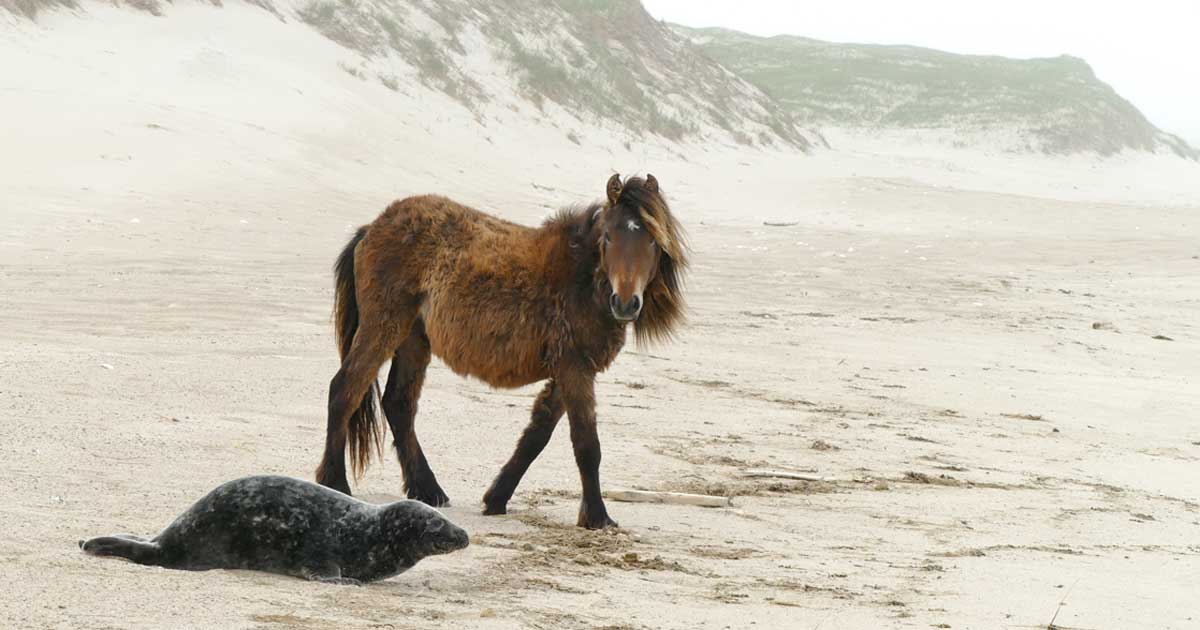
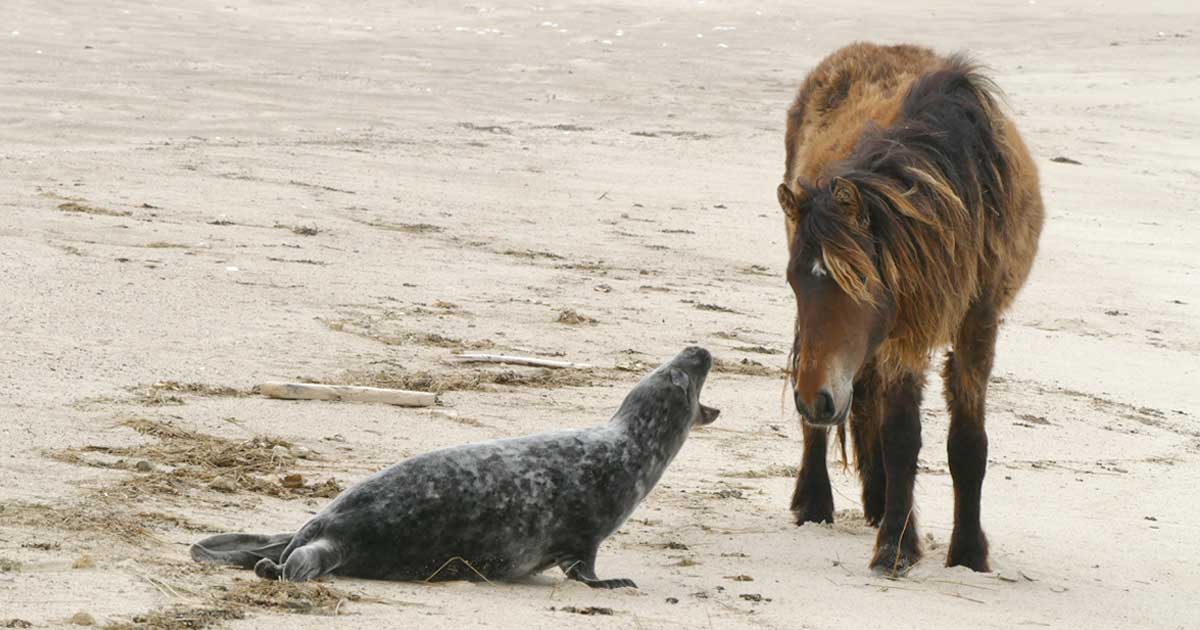 A young Sable Island horse, still shaggy in his winter coat, and a young Grey Seal on the north beach. The seal would have been born during the past winter’s pupping season, so, he is five to six months old. They weren’t really hanging out together, but both were moving towards the water’s edge at the same time. When the horse stopped to sample the interesting scent of the seal, the seal expressed some irritation.
A young Sable Island horse, still shaggy in his winter coat, and a young Grey Seal on the north beach. The seal would have been born during the past winter’s pupping season, so, he is five to six months old. They weren’t really hanging out together, but both were moving towards the water’s edge at the same time. When the horse stopped to sample the interesting scent of the seal, the seal expressed some irritation.
Posted on Facebook, June 10, 2020
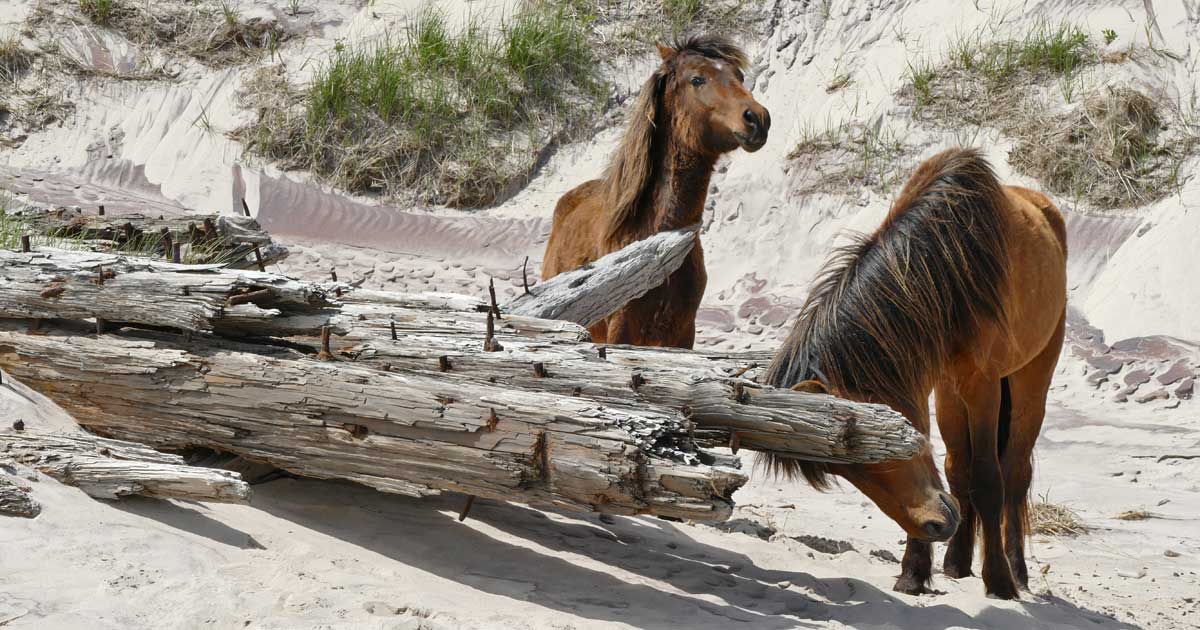 Sable Island horses enjoying a rub on a large piece of shipwreck at the base of a high south beach dune. The wreckage was long ago buried by sand, and the windblown sand had become a dune. Eventually the dune began to erode and retreat, and the wreckage was slowly exposed. Thirty years ago only a few parts—some wood and ironwork—were visible. Even then it was a favourite rubbing and scratching site for the horses.
Sable Island horses enjoying a rub on a large piece of shipwreck at the base of a high south beach dune. The wreckage was long ago buried by sand, and the windblown sand had become a dune. Eventually the dune began to erode and retreat, and the wreckage was slowly exposed. Thirty years ago only a few parts—some wood and ironwork—were visible. Even then it was a favourite rubbing and scratching site for the horses.
Posted on Facebook, June 9, 2020

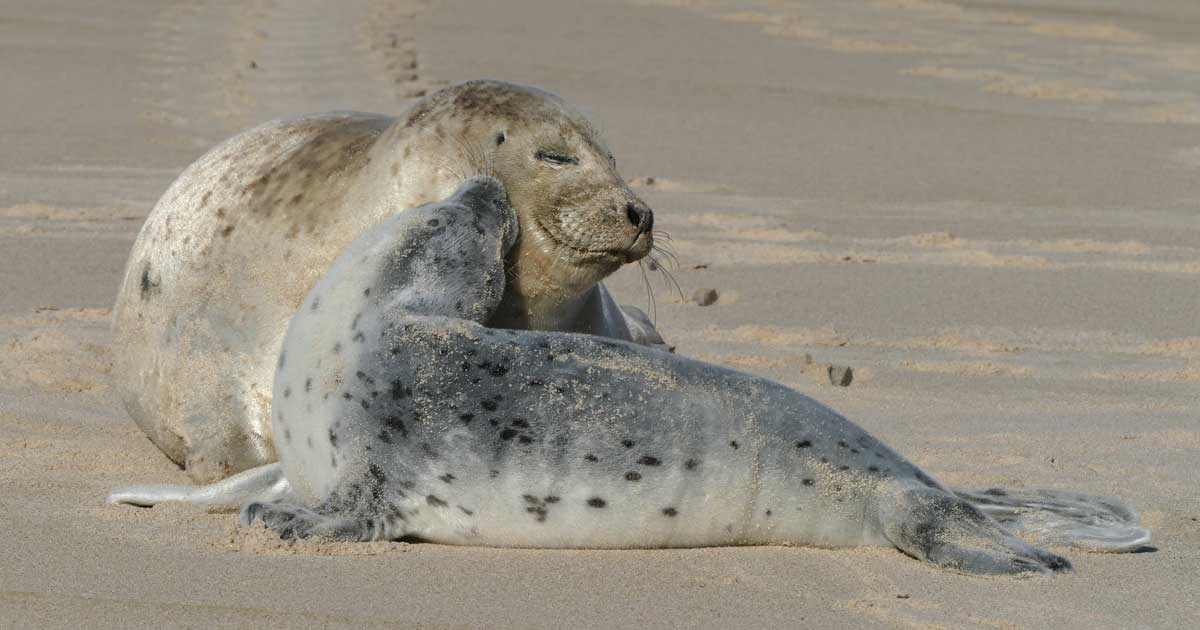 A Sable Island Harbour seal and her pup, born during the first week of June, resting on the north beach. The average weight of a new-born Harbour Seal pup is 10.9 kg. The mother’s milk is rich (containing 50% fat) and during the 24-day nursing period the pup gains about 14 kg, more than doubling its birth weight. Harbour seal pups are able to enter the water and swim with their mothers within a few hours of birth.
A Sable Island Harbour seal and her pup, born during the first week of June, resting on the north beach. The average weight of a new-born Harbour Seal pup is 10.9 kg. The mother’s milk is rich (containing 50% fat) and during the 24-day nursing period the pup gains about 14 kg, more than doubling its birth weight. Harbour seal pups are able to enter the water and swim with their mothers within a few hours of birth.
Posted on Facebook, June 8, 2020
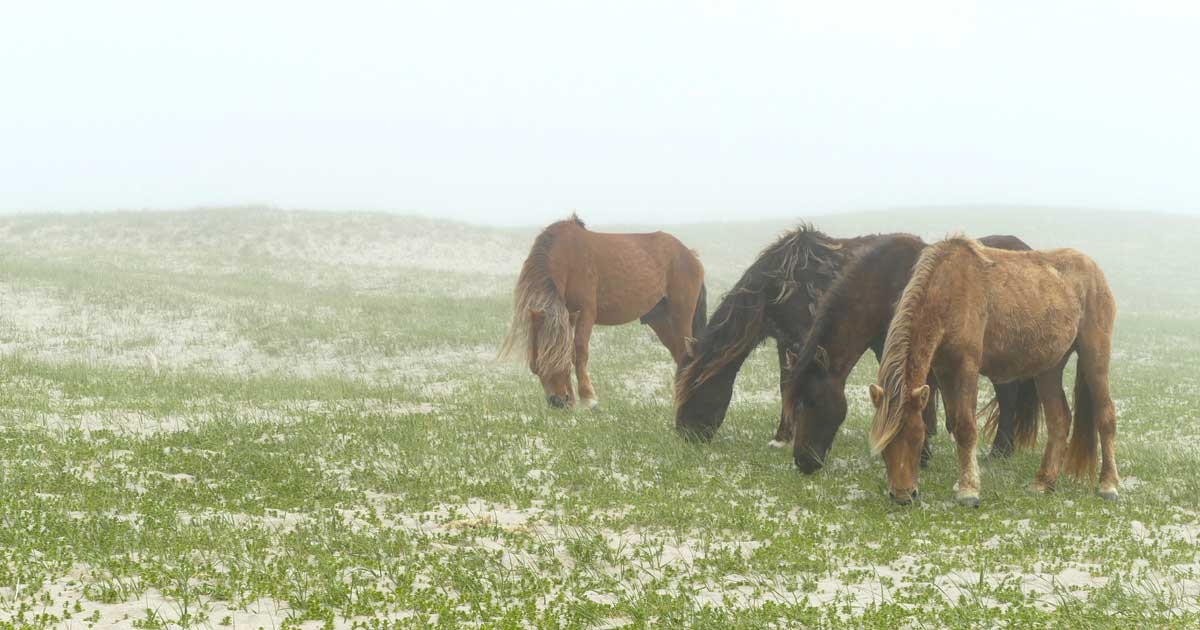
 Spring on Sable Island. With many days of rain and fog, the dune vegetation seems to be enjoying the soggy weather. The landscape is green with marram grass and beach pea. On the west spit, a family band of horses grazes the fresh growth of sandwort. Later, in early evening, the fog cleared away and a solitary horse wandering along north beach stopped to stand for a few moments in the swash of the waves over the berm.
Spring on Sable Island. With many days of rain and fog, the dune vegetation seems to be enjoying the soggy weather. The landscape is green with marram grass and beach pea. On the west spit, a family band of horses grazes the fresh growth of sandwort. Later, in early evening, the fog cleared away and a solitary horse wandering along north beach stopped to stand for a few moments in the swash of the waves over the berm.
Zoe Lucas, Sable Island Institute
June 8 – July 11, 2020
For Zoe’s other series of Facebook posts, see:
Series No.2, Posted on Facebook, October 9 – November 7, 2020
Series No.3, Posted on Facebook, November 8 – December 12, 2020
Series No.4, Posted on Facebook, October 26 – November 28, 2021


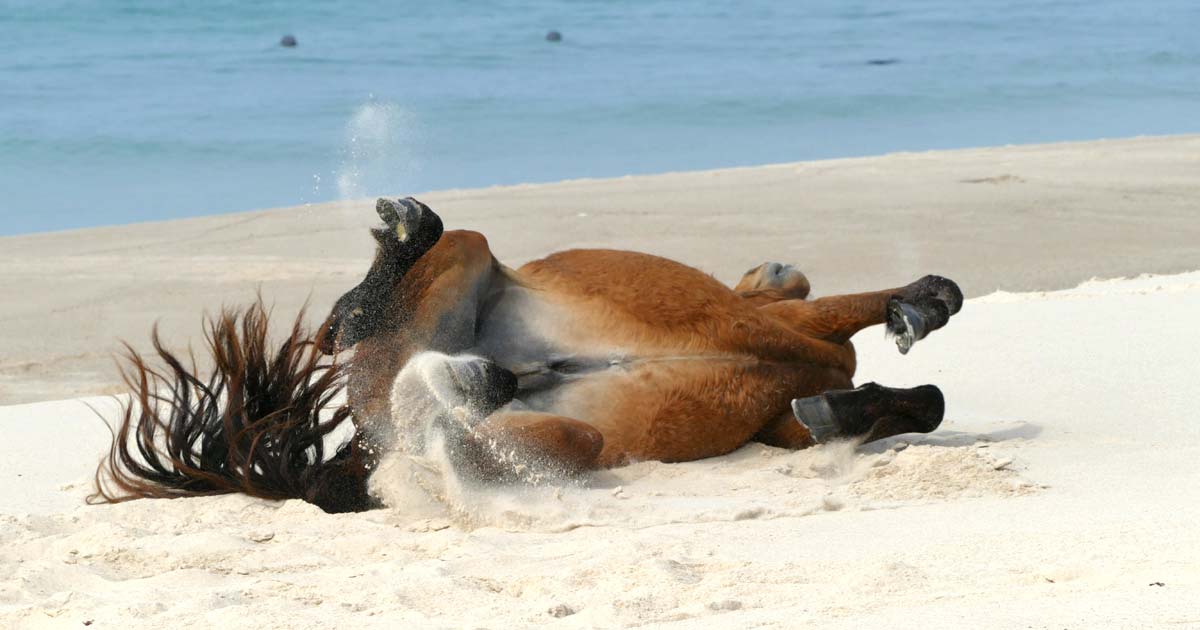
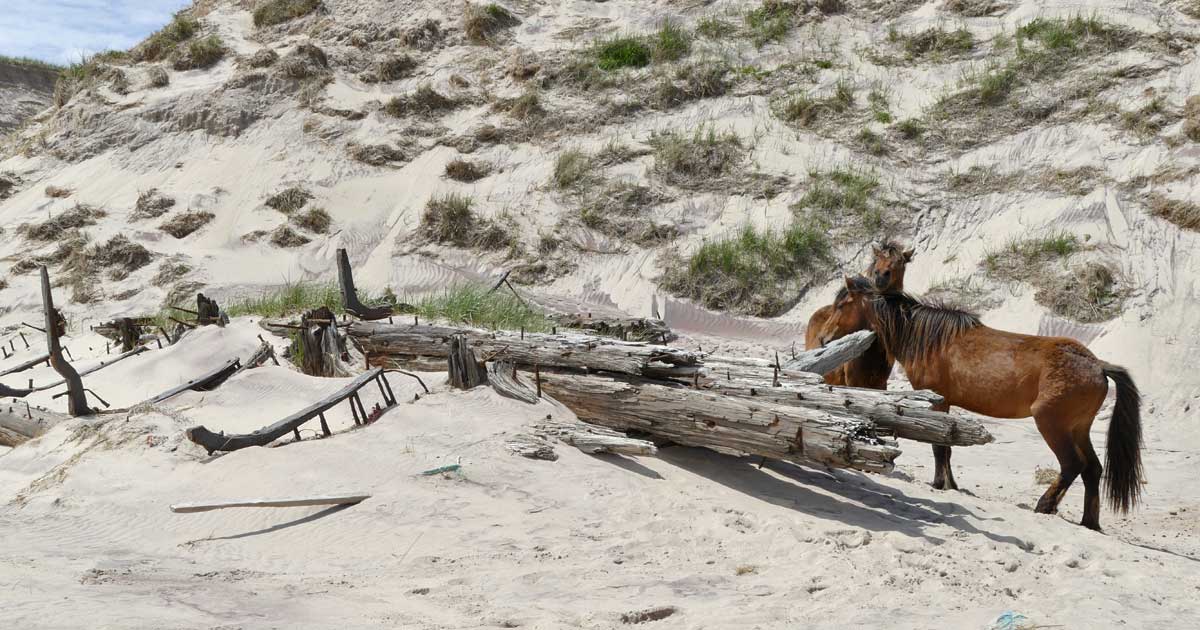
One Response
Love the young seal and horse encounter. Can just imagine what the seal might be saying.